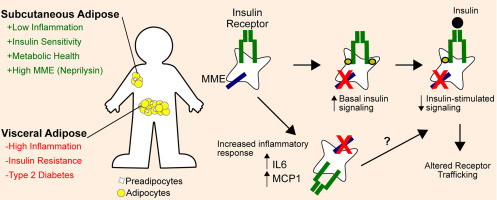Molecular Metabolism ( IF 7.0 ) Pub Date : 2019-01-25 , DOI: 10.1016/j.molmet.2019.01.006
Alfred K Ramirez 1 , Simon Dankel 2 , Weikang Cai 3 , Masaji Sakaguchi 3 , Simon Kasif 4 , C Ronald Kahn 3

|
Objective
Accumulation of visceral white adipose tissue (WAT) associates with insulin resistance, adipose tissue inflammation, and metabolic syndrome, whereas accumulation of subcutaneous WAT may be protective. We aimed to identify molecular mechanisms that might provide mechanistic insights underlying the phenotypic differences in these tissues. Membrane Metallo-Endopeptidase (MME/Neprislyin) is an extracellular, membrane-bound protease enriched in subcutaneous WAT that can target degradation of a variety of peptides, including insulin, IL6, and β-amyloids. We hypothesized that MME contributes to adipose depot-specific metabolic properties.
Methods
We performed RNA sequencing on human subcutaneous and visceral preadipocytes and array gene expression profiling in murine subcutaneous and visceral preadipocytes. We conducted several insulin signaling and inflammatory response experiments on different cellular states of MME expression.
Results
MME in white preadipocytes is expressed at a higher level in subcutaneous compared to visceral WAT and favors insulin signaling and a low inflammatory response. Thus, knockdown of MME in subcutaneous preadipocytes increased the inflammatory response to substance P and amyloid β aggregates. This associated with increased basal insulin signaling and decreased insulin-stimulated signaling. Moreover, MME differentially regulates the internalization and turnover of the α/β subunits of the insulin receptor.
Conclusion
MME is a novel regulator of the insulin receptor in adipose tissue. Given the clinical significance of both chronic inflammation and insulin sensitivity in metabolic disease, these results show a potentially new target to increase insulin sensitivity and decrease inflammatory susceptibility.
中文翻译:

膜金属内肽酶(脑啡肽酶)调节白色前脂肪细胞中的炎症反应和胰岛素信号传导。
客观的
内脏白色脂肪组织 (WAT) 的积累与胰岛素抵抗、脂肪组织炎症和代谢综合征相关,而皮下 WAT 的积累可能具有保护作用。我们的目的是确定可能提供这些组织表型差异背后的机制见解的分子机制。膜金属内肽酶 (MME/Neprislyin) 是一种富含皮下 WAT 的细胞外膜结合蛋白酶,可以降解多种肽,包括胰岛素、IL6 和 β-淀粉样蛋白。我们假设 MME 有助于脂肪库特异性代谢特性。
方法
我们对人皮下和内脏前脂肪细胞进行了 RNA 测序,并对小鼠皮下和内脏前脂肪细胞进行了基因表达谱分析。我们对 MME 表达的不同细胞状态进行了多项胰岛素信号传导和炎症反应实验。
结果
与内脏 WAT 相比,白色前脂肪细胞中的 MME 在皮下表达水平更高,有利于胰岛素信号传导和低炎症反应。因此,皮下前脂肪细胞中 MME 的敲低增加了对 P 物质和 β 淀粉样蛋白聚集体的炎症反应。这与基础胰岛素信号传导增加和胰岛素刺激信号传导减少有关。此外,MME 差异性地调节胰岛素受体 α/β 亚基的内化和周转。
结论
MME 是脂肪组织中胰岛素受体的新型调节剂。鉴于慢性炎症和胰岛素敏感性在代谢疾病中的临床意义,这些结果表明了增加胰岛素敏感性和降低炎症易感性的潜在新目标。































 京公网安备 11010802027423号
京公网安备 11010802027423号